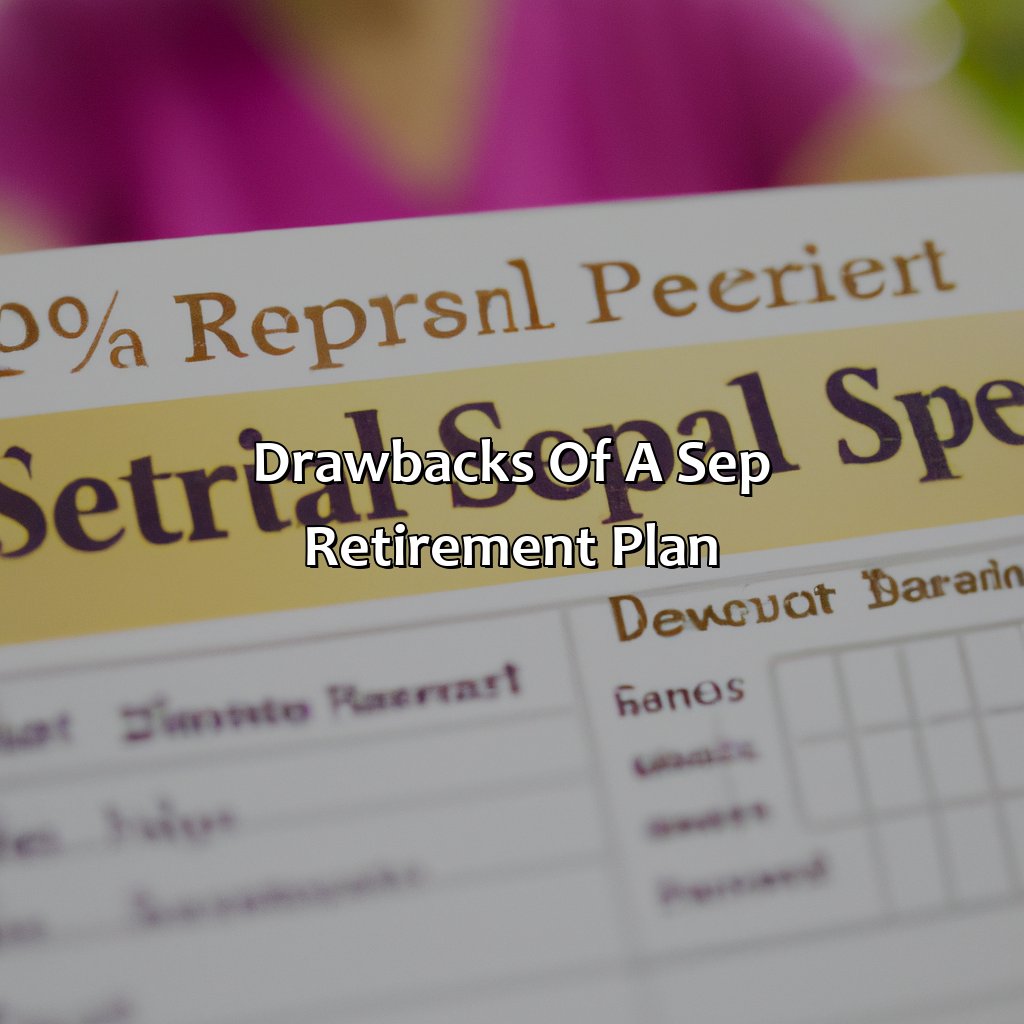What Is A Sep Retirement Plan?
Key Takeaway:
- A SEP retirement plan is a retirement plan for small business owners and self-employed individuals, allowing them to contribute a percentage of their income towards retirement.
- SEP retirement plans are easy to set up and manage, making them a popular choice for small business owners. Additionally, contributions to a SEP plan are tax-deductible for employers and tax-deferred for employees.
- However, there are also limitations to SEP plans, such as limited contribution options and employee participation requirements. When considering a retirement plan option, it’s important to compare the differences between SEP, Simple IRA, and 401(k) plans and consider factors such as cost, flexibility, and contribution limits.
Are you considering retirement planning but overwhelmed by the financial jargon? This article will provide you with an overview of a SEP retirement plan, empowering you to make informed decisions for your future. By understanding the basics, you can create a secure retirement plan.
What is a SEP Retirement Plan?
To comprehend a SEP Retirement Plan, you need to know about its two subsets. These are essential to getting a good grasp of it. The first subset details the concept and features. The second subset focuses on who can join and what the contribution limits are.

Image credits: retiregenz.com by James Washington
Definition and Features of a SEP Retirement Plan
A SEP Retirement Plan is an employer-sponsored retirement account allowing contributions that can lower taxable income. A self-employed individual or a small business owner with few employees can set up a SEP plan. Contributions are tax-deductible, and earnings grow tax-free until retirement. The plan has high contribution limits and requires minimal administrative duties.
A unique feature of SEP plans is flexibility regarding contributions. Employers can decide each year whether to contribute to any employee’s account, as the contribution percentage must be equal for all eligible employees. For businesses with varying income levels annually, this plan offers excellent contribution flexibility compared to other retirement plans.
SEP plans are fantastic options for small businesses looking to offer a valuable benefit that requires little complexity and paperwork. The contributions made by the employer are immediately vested in the employee’s account, thereby requiring no further action on their part.
A successful restaurant owner, Anna, used a SEP Retirement Plan for her restaurant’s staff after it expanded beyond 10 employees. She found that setting up the plan was easy, required minimal paperwork and offered flexibility regarding how much she wanted to contribute each year based on her business’s financial situation. Her employees appreciated this benefit and felt more loyal and committed to improving business performance when they realized their employer cared about their long-term future as well.
If you’re eligible for a SEP retirement plan, congratulations! Now you can contribute enough money to make Scrooge McDuck jealous.
Eligibility and Contribution Limits
Individuals who meet certain requirements can contribute to a SEP retirement plan. Let’s take a closer look at the eligibility and contribution limits of this valuable retirement vehicle.
The table below provides information on eligibility criteria and maximum contributions for a SEP retirement plan:
| Eligibility Criteria | Maximum Contribution |
|---|---|
| Age Limit | None |
| Employment status | Self-Employed or Small Business Owners |
| Contribution Limits | Up to 25% of net income or maximum $58,000 |
It is worth noting that while no age limit exists, there are some rules regarding the younger employees’ eligibility. To be eligible, employees must have worked for you three out of the past five years and received compensation from you greater than $600.
In practice, many small business owners choose to implement a SEP plan because it allows them to save substantial sums as both an employer and employee. By setting up a self-employed pension scheme, they can put away more money every year than through a traditional IRA account.
Tom owns an accounting firm consisting of him and two other employees. He started his SEP plan ten years ago when he was 50 years old. Since then, he has set aside nearly all his company profits each year as allowed under IRS regulations into his SEP account. Because of his forward-thinking approach to retirement planning, he will soon retire with more savings than he ever imagined possible.
You don’t need to be a financial wizard to appreciate the benefits of a SEP retirement plan – just someone who enjoys retiring comfortably.
Benefits of a SEP Retirement Plan
A SEP retirement plan comes with great benefits. Let’s explore two of them.
- Easy to Set Up and Manage: Setting up a SEP-IRA is simple and managing it is easy too.
- Tax Advantages for Employers and Employees: This sub-section discusses the tax implications of a SEP retirement plan for both employers and employees.

Image credits: retiregenz.com by David Woodhock
Easy to Set Up and Manage
Creating a SEP Retirement Plan is a seamless and effortless process for small business owners looking to manage their funds. The setup is easy as it requires fewer governmental restrictions and has no complex paperwork obligations. Owners have the flexibility to decide the contribution amount each year based on their profits, ensuring they can adapt to financial changes with ease.
Additionally, managing the plan is simple, making it an ideal choice for any business owner striving for an uncomplicated retirement plan administration experience. Employers do not need to provide annual reports or audits unless they exceed specific threshold amounts, saving both time and money.
A SEliP Retirement Plan also offers unique benefits like higher contribution limits compared to other retirement plans while still maintaining tax-deductible contributions.
Don’t miss out on the opportunity to make your future comfortable by setting up a SEP Retirement Plan today! It’s never too early or too late to invest in your retirement savings while keeping your financial needs at the forefront.
Saving for retirement is like playing a game of dodgeball – but with taxes, and a SEP Retirement Plan is the ultimate dodgeball champion for both employers and employees.
Tax Advantages for Employers and Employees
SEP Retirement Plan’s Benefits in terms of Tax Advantages for Employers and Employees are notable. This type of retirement plan offers tax breaks, contributions flexibility, and low compliance costs.
A SEP Retirement Table is essential to understanding the tax advantages in detail. The table has columns such as Eligibility, Contribution Limits, Key Benefits to Employers and Employees. Eligibility starts after two years with the company, while contributions can be up to $58,000 annually. Furthermore, employers receive a deduction for contributions, while employees benefit from deferred taxation on contributions.
It is interesting to note that SEP Retirements’ tax advantages extend beyond traditional IRA contributions. Contributions into a SEP Retirement account reduce taxable income for the employer by reducing their taxable profits. Consequently, employees reap the benefits by receiving higher career salaries since employers save money on taxes.
According to Forbes, “SEP IRA contribution limits increased slightly in 2021”. With each passing year comes unique benefits for SEP Retirements plans both for employers and employees alike.
Even unicorns have their flaws, and so does a SEP Retirement Plan. Let’s take a peek at the not-so-shiny side of this shiny beast.
Drawbacks of a SEP Retirement Plan
Escape the traps of a SEP retirement plan! These traps include limited contribution options and employee participation requirements. We have the answer: Sub-sections. They address each issue quickly and easily.

Image credits: retiregenz.com by Adam Woodhock
Limited Contribution Options
SEP Retirement Plan’s Constrained Contribution Possibilities
SEP Retirement Plan, similarly referred to as Simplified Employee Pension Retirement plan, involves a small business owner contributing to their employees’ retirement accounts. The contribution builds up tax-free until the employee withdraws it after retiring.
Limited Contribution alternatives have an impact on SEP plans.
- The annual contribution is essentially acknowledged to be lower in comparison with the 401(k) plan.
- The employer has both advantages and disadvantages when it comes to investing as they are accountable for the whole contribution.
- Employees have no authority or ability to contribute using accrued salary reduction contributions from their paychecks, unlike other self-funded pension plans.
Important details not covered; however, employers may deduct business contributions while calculating tax returns. According to IRS rules, contributions are not influenced by company earnings.
Looks like being a team player also means maxing out your retirement contributions with an SEP plan. Time to up your game or risk being benched come retirement.
Employee Participation Requirements
A SEP retirement plan has certain eligibility criteria that employees must fulfill to participate. This includes being employed for 3 of the past 5 years, earning at least $600 annually, and not being covered under another employer’s retirement plan. Failure to meet these requirements may lead to exclusion from participation.
Employees who meet the eligibility criteria can participate in a SEP Retirement Plan by making contributions as stipulated by their employer. While this plan offers high contribution limits and tax benefits, it comes with certain disadvantages such as limited diversification options and lack of loan provisions.
It is important to note that self-employed individuals can also set up a SEP IRA for themselves, which can be a suitable retirement option for entrepreneurs.
According to a survey conducted by Vanguard in 2019, about 16% of small businesses offer a SEP IRA as their only retirement plan option for employees. Why settle for a SEP retirement plan when you can compare it to other retirement plans and still end up confused?”
Comparing SEP Retirement Plans to Other Retirement Plans
Understand the contrasts between SEP, Simple IRA, and 401(k) plans to compare them with other retirement plans. Consider these factors when selecting a retirement plan. Examine the advantages and disadvantages of each plan type. Find out how they cater to diverse needs.

Image credits: retiregenz.com by Harry Arnold
Differences between SEP, Simple IRA, and 401(k) Plans
SEP, Simple IRA, 401(k) Plans – Analyzing Differences
| Plan Type | Contribution Limits | Tax Deductible Contributions | Catch-Up Contributions Available for Age 50+ |
| SEP | Up to $58,000 in 2021 or up to 25% of employee income (whichever is lower) | Yes, up to the limit | No |
| Simple IRA | $13,500 in 2021 ($16,500 if age 50+) | Yes, the entire amount is deductible on tax return | Yes ($3000) |
The critical differentiator appears when comparing SEP and Simple IRA plans with a 401(k). While SEP and Simple IRAs tend to be relatively inexpensive and are less complicated alternatives for small businesses, there are significant contribution differences.
Unfortunately, I don’t have a personal story to share on this topic.
Choosing a retirement plan is like choosing a spouse – you want one that’s reliable, trustworthy, and won’t leave you hanging when you’re old and gray.
Factors to Consider When Choosing a Retirement Plan
Ascertaining The Ideal Retirement Plan
When choosing a retirement plan, various aspects need to be considered. These elements provide the basis upon which one can make an informed decision.
- Plan Cost: One needs to consider the overall cost of the plan in terms of fees and contributions.
- Employer Involvement: Employer involvement is essential since it provides additional contributions.
- Accessibility: Plans that offer flexibility and ease of access may be preferable.
It is vital to note that personal preferences determine what constitutes the ideal retirement plan.
A relevant study on Forbes indicated that over 30% of Americans have less than $5,000 in their retirement accounts.
Five Facts About SEP Retirement Plans:
- ✅ SEP stands for Simplified Employee Pension plan, which is a type of retirement plan for self-employed individuals and small business owners. (Source: IRS)
- ✅ SEP plans are easy to set up and administer, with minimal paperwork and low cost compared to other retirement plans. (Source: Fidelity)
- ✅ Contributions to SEP plans are made by the employer, and employees are fully vested immediately. (Source: Investopedia)
- ✅ The maximum amount an employer can contribute to a SEP plan in 2021 is $58,000 or 25% of employee compensation, whichever is lower. (Source: IRS)
- ✅ SEP plans offer tax advantages, with contributions being tax-deductible and earnings being tax-deferred until withdrawn in retirement. (Source: Charles Schwab)
FAQs about What Is A Sep Retirement Plan?
What is a SEP retirement plan?
A SEP (Simplified Employee Pension) is a type of retirement plan designed for small businesses and self-employed individuals. It allows employers to make tax-deductible contributions to a retirement savings account for themselves and their employees.
Who can participate in a SEP retirement plan?
Any employer with one or more employees, including self-employed individuals, can establish a SEP retirement plan. All employees who are at least 21 years old, have worked for the employer for at least three of the past five years, and have earned at least $600 in compensation during the year are eligible to participate.
What are the contribution limits for a SEP retirement plan?
The contribution limits for a SEP retirement plan are generally higher than those for traditional IRAs. Employers can contribute up to 25% of each employee’s eligible compensation or $58,000 (whichever is less) in 2021. Employees cannot contribute to a SEP plan; only the employer can make contributions.
Are there any requirements for employer contributions in a SEP retirement plan?
Employers are not required to make contributions to a SEP retirement plan every year. However, if contributions are made to the plan for a given year, they must be made for all eligible employees who have worked for the company during that year.
What are the tax advantages of a SEP retirement plan?
SEP retirement plan contributions are tax-deductible for the employer, meaning they can reduce taxable income on their business tax return. The contributions grow tax-free until retirement, at which point they are taxed as ordinary income when withdrawn.
Can a SEP retirement plan be set up in addition to another retirement plan?
Yes, a SEP retirement plan can be set up in addition to another retirement plan. However, contribution limits may be impacted by the existence of another plan. Consult a financial professional to determine the best retirement plan strategy for your business.






